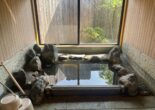
Why Yokohama?
My husband and I moved to Yokohama in summer of 2011. The main reason we chose Yokohama was for his job. But the city has a lot to offer, and it is well located for easy access to some great locations in the region.
We’ve been here six years and are still discovering new and interesting places. Now we have a boy who just turned three we are learning about lots of new places which are ideal for families. Our neighbors are a great source of local information and knowledge.
I have lived in Japan for more the 12 years in total (how did that happen?!) and the initial excitement of life in Japan has long since worn off. But I love living in a place where there are still lots of new places to discover.
And Yokohama is a constantly moving city; there is always something new happening. This year the city has created “Yokohama Garden Necklace” with flower displays in even the most suburban spots. So, even the familiar places around town never stay the same.
Yokohama’s History
Yokohama is Japan’s second-largest city, but it is home to many “firsts” for Japan. Although just 30-45 minutes south of Tokyo it is a place with a distinct character and class all it’s own.
The first foreign settlements in Japan
The history of modern era Japan ideal into the city.
In the mid-1800’s Commodore Perry arrived in Yokohama to convince Japan to open for foreign trade. It had been a regular fishing village, but it in light of new trade agreements it became an international port. Yokohama hasn’t looked back.
The Western influences are still visible today. The architecture and attitude of the people have a Western flavor. The wide open spaces and stylish locals give Yokohama a cosmopolitan feel.
A foreign settlement was established in the area known as Kannai. And over time foreign homes, schools and businesses took over the hills in Yamate. And as well as the Western influence there is also a large China Town.
The city was destroyed in the 1923 Great Earthquake, so most of the historic areas post-date that time. But you can get a feel for what it would have been like to be a foreign resident in Japan a century ago. How did people survive without iPhones, high-speed Internet, conbini and Amazon?
Firsts for Japan in Yokohama
Before the opening to the West, dairy products were not part of the Japanese diet. Along with the foreign residents, Yokohama was home to the first dairy farm in Japan. There has been a butter shortage in recent years. But, those early settlers had to import cows and dairy production methods. Imagine life with no butter or cheese?
And who doesn’t enjoy a Japanese beer under the sakura or in the summer months when beer gardens appear? The first brewery in Japan was founded by foreign residents in Yokohama. Today the company is now known as Kirin beer, one of the major Japanese breweries.
These are just a couple of the firsts introduced into Japan by residents of Yokohama. For a history buff, it’s a fascinating place to be.
Year Round Events
Another reason Yokohama is a great place to live is that there is always something to do all year long.
In particular, the areas around Akarenga Soko (Red Brick building) and Yamashita Koen always have something going on. Many events are annual features on the local calendar and others pop up from one year to the next.
In summer Akarenga is turned into a tropical beach. Each year is a slightly different theme, but white sand and mojitos always feature. Without leaving the city, you can imagine you are somewhere tropical and the kids can play of fake sand.
In winter time the same area hosts a German Christmas market. If KFC and “kurisumasu keiki” are all making you long for a real Christmas atmosphere, the Christmas market comes close.
Other annual events include Oktoberfest, Diwali celebrations, and even a gyoza event. In the last couple of years, Pokemon parades have become a staple of the summer months. Which is a bizarre site to behold.
This year there was a strawberry festival which I’d not seen before. There’s almost always something new and exciting happening. The event planners in the city must be having fun.
Some Yokohama Highlights
It’s impossible to go into all the things to see and do in the city. The main tourist areas center along the water front and beyond. Let me briefly tell you about those places.
Minato Mirai
Minato Mirai means “Future Port.” The architecture reflects the aspirations of modern Japan. Sleek new and forward looking. The area has shopping malls, hotels, a large event space, and offices. Several international companies have offices near here.
The Nissan Global HQ, for example, is a fun place to hang out, whether you want to buy a car or not. The showroom has space for small children to play and a Starbucks right inside the building. You’re free to walk around and check out the electric vehicles or more classic Nissan cars.
Nearer to the water there’s a small theme park with a Ferris wheel that defines the landscape. You can even make your own Cup Noodles at the Cup Noodle Museum. The most prominent building in the area is Landmark Tower. On a clear day, you can see Mt Fuji from the observation deck.
The area in front of Yokohama Museum of Art, and beyond has recently been renovated. Water fountains shoot jets of water into the air at regular intervals. The under-5 set gravitates to this area in the hot summer months.
Motomachi Chukagai
The final stop on the Toyoko/ Minato Mirai line, which connects Yokohama to Tokyo, is Motomachi Chukagai. Motomachi is a shopping street which looks like it belongs to another era. Western shops and expensive jewelry stores line the street.
It is also the location for annual events like the St Patricks Day parade. There’s a bookshop with a decent English section and import food shop as well.
On the other side of the river is Chukagai (China Town). It is a maze of Chinese restaurants and stores. Clothes and souvenirs, Chinese ingredients and cooking tools all line the shelves.
Chukagai comes alive at Chinese New Year with dragon dances and fire crackers. But at any time of year, it is colorful and filled with stalls selling Nikuman or Pearl Tea.
Yamate and the Bluff
On the hills behind Motomachi, you can find the historic residencies of Western merchants and diplomats. The Foreign Cemetry also sits on the top of the hill overlooking Yokohama. Most of the houses are open for tourists, although the cemetery is only open on specific days.
Two big International schools are also found in this area. Both schools run fayres in the Autumn months. Anyone can drop by to sample food from around the world and connect with local business owners selling their goods.
When I first arrived in Japan, the thought of walking around exciting houses didn’t appeal to me at all. But the longer I live here, the more I appreciate the area. I can let my imagination run wild and wonder what it would have been like to live in Japan in the 1920’s or 30’s. It’s also like getting a taste of “home” without leaving Yokohama.
Great things about living in Yokohama
As well as all the things I have already mentioned it’s a great city to live in for families with little kids. There’s parks, free playrooms like Smile Port in Minato Mirai. There are also “log houses” in various locations throughout Yokohama. Free wooden playhouses, kind of like soft play without the soft part.
For foreign residents, there is also a great support system if you ever need language support. YOKE can send volunteer translators to help support with whatever you need. They also run safety classes for foreign moms in the city as well as international exchange.
The only downside to Yokohama is that is quite spread out. It can be difficult to get to all the great parks and play areas without a car. I often find myself having to take a bus and one or more trains to get to wherever I want to go.
Beyond Yokohama
The final thing I love about Yokohama is in a great location for getting to many places. It is within easy traveling distance of Tokyo if you need to go there for work or other reasons. But it is also easy to get to Kamakura and beyond. Enoshima and the Shonan coast are also very accessible. So when I’m tired of city life, I can escape to the mountains and temples of Kamakura or the laid back feel of the coast.



